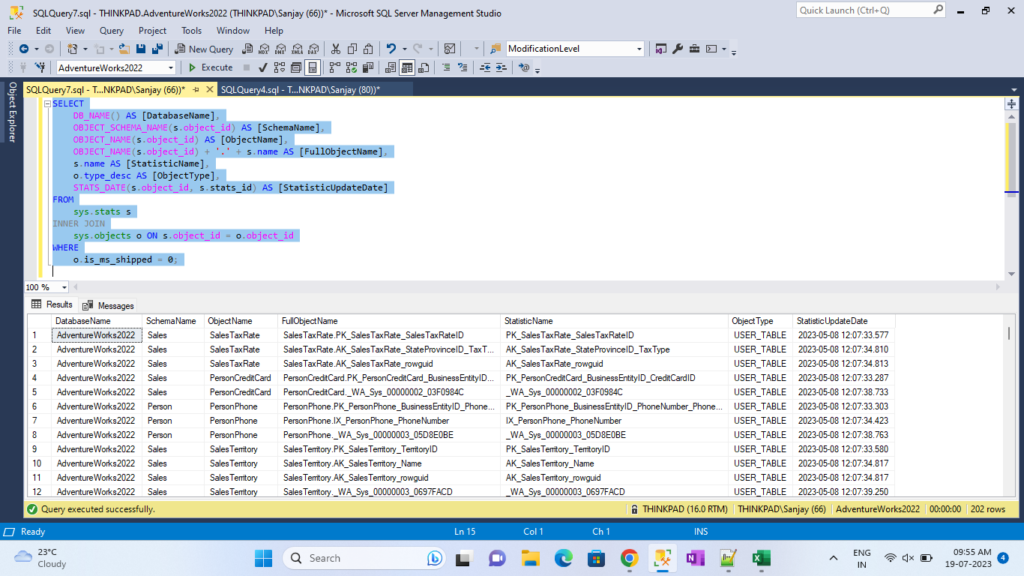Introduction
In the world of database management, understanding the statistics of your SQL Server database is crucial for optimizing query performance. SQL Server provides a powerful set of system views to retrieve valuable information about database statistics. In this blog post, we will explore how to analyze statistics using T-SQL and discuss the importance of each column in the result set.
Analyzing Statistics with T-SQL
To begin our exploration, let’s consider a T-SQL query that retrieves statistics information from the sys.stats view:
SELECT
DB_NAME() AS [DatabaseName],
OBJECT_SCHEMA_NAME(s.object_id) AS [SchemaName],
OBJECT_NAME(s.object_id) AS [ObjectName],
OBJECT_NAME(s.object_id) + '.' + s.name AS [FullObjectName],
s.name AS [StatisticName],
o.type_desc AS [ObjectType],
STATS_DATE(s.object_id, s.stats_id) AS [StatisticUpdateDate]
FROM
sys.stats s
INNER JOIN
sys.objects o ON s.object_id = o.object_id
WHERE
o.is_ms_shipped = 0
ORDER BY
STATS_DATE(s.object_id, s.stats_id) DESC;
DatabaseName: The first column, [DatabaseName], provides the name of the current database. It helps in identifying the specific database being analyzed.
SchemaName and ObjectName: These columns, [SchemaName] and [ObjectName], provide information about the schema and name of the object associated with the statistic. By understanding the object hierarchy, we can pinpoint the specific area of the database where statistics are relevant.
FullObjectName: The [FullObjectName] column concatenates the object name with the statistic name, separated by a period (‘.’). It gives us the complete path of the object and statistic within the database.
StatisticName: The [StatisticName] column represents the name of the statistic being analyzed. Each statistic provides valuable insights into the distribution of data within the associated object.
ObjectType: The [ObjectType] column describes the type of the object, whether it is a table, view, or another type of object. This information helps in understanding the nature of the object being analyzed.
StatisticUpdateDate: The last column, [StatisticUpdateDate], reveals the date and time when the statistic was last updated. It is crucial for monitoring and ensuring that the statistics are up to date, as outdated statistics can lead to suboptimal query performance.
Conclusion
In this blog post, we explored how to analyze statistics in SQL Server using T-SQL. By querying the sys.stats system view and combining it with other relevant views, we obtained a comprehensive set of information about database statistics.
Understanding the columns retrieved from the sys.stats view allows us to gain insights into the distribution of data within objects, identify areas that might benefit from statistics updates, and optimize query performance. By regularly analyzing and maintaining statistics, database administrators can ensure efficient query execution and enhance the overall performance of their SQL Server databases.
Remember, statistics play a vital role in the query optimizer’s decision-making process, so keeping them up to date is essential. Incorporating the information retrieved from the sys.stats view into your database management practices will contribute to a more robust and optimized SQL Server environment.
References:
- Microsoft Docs: sys.stats (Transact-SQL)
- Microsoft Docs: Querying the SQL Server System Catalog FAQ
Disclaimer: This blog post provides an overview of analyzing statistics in SQL Server using T-SQL. It is recommended to refer to the official Microsoft SQL Server documentation and consult with experienced database professionals for comprehensive guidance and best practices specific to your environment.





